You may or may not remember that we went to Oslo, Norway this year…
to babysit. London was a bit like that, but it started with
“Alison, pick something you really want to do for your sixtieth
birthday.” As it turns out, Alison had just seen an advertisement
for a play based on her favorite anime, “Spirited Away.” Which was
playing… yes, you guessed it.
On the other hand, we’ve settled on
doing one or two European trips during the year, with a stop in Ireland
to visit Brie, Aidan, and Little Dave. This year, Alison will be doing
four, but who’s counting?

You're leaving us ... AGAIN?
The idea was to spend four days in London with a two-day stay in Ireland on the way back. We did Aer Lingus business class to Dublin to get a few hours of sleep in the “lay flat” seats (and have a more comfortable time on the seven-hour flight back), with separate British Airways economy tickets to London (an hour and a half flight). Transfer in Dublin went well enough; we had to exit and re-enter the security line (and learned that you want “Fastrack” in Ireland, which you fortunately get with business class tickets).

Arrival in London was easy because, for reasons that are still not clear, London doesn’t have a passport/customs check, so we just walked out to a Blacklane Limo I’d reserved after retrieving our luggage. An hour later, we were at the Conrad on St. James Street (it’s the same boutique hotel we stay at when we go to Gencon in Indianapolis). The Conrad is in the heart of the touristy part of London and allowed us to walk to everything we wanted to see except Highgate Cemetery (which we ended up missing anyway). The Conrad lived up to its five-star rating except for the Pem, the hotel restaurant, which was disappointing (but we liked the separate pub).
|
|
The Pem
Piece of art at the Conrad called "The House Always Wins" that depicts each house of commons representative with a monster equivalent
The trip was good; we had two activities each day, a morning and
an afternoon excursion (and, on the day of the play, the play in the
evening). That was perhaps a little overscheduled, as it turned
out, but there was a list and only five days, so…
Big picture,
London is London and you’d think the British Empire was alive and well
instead of the wreck of an economy that’s the rest of the UK after
Brexit. It was crowded, it was posh, it was expensive, and it was
as diverse a city as we’ve ever visited. You walked down the
street and heard at least a half dozen different languages being spoken.
The only thing that really marred the trip was a bout of food poisoning
for Alison, which did kind of put a damper on the back half of the trip.
But, as the Brits like to say, shite happens.
Day 1
We arrived at the Conrad around 11 with an early check-in; after dropping things in our room, we had just enough time to walk over to the National Gallery for our 1:00 entry time. Even the walk was enticing; four large parks span the entire area (Kensington, Hyde, St. James, and … some other parks). They are all full of very tame ducks, swans, squirrels, pigeons, and other wildlife that march up and demand snacks as you walk by. Plus statues and quaint little cottages with no discernable purpose (we were guessing groundskeeper housing?). Streets are littered with statues, pillars, and buildings that look like they were used to film “Bridgerton,” along side buildings as modern as yesterday.
Blue Bridge looking towards Whitehall
Where are the hobbits? |
Evil eye |
Face Off |
Solid advice... |
Nelson's column, with plaques made from the melted cannons from the French and Spanish warships he defeated |
Funny story; we saw the building with the big globe and we couldn't find it on the map ... and it turned out to be the theater where "Spirited Away" was playing |
One side of the street |
The other side of the street |

Whitehall
We had a two-hour slot at the National Gallery (not prescribed, we just had tickets for the nearby National Portrait Gallery at three). There are something like 100 separate rooms in the NG, dedicated to this, that, or the other thing. And every one of them had multiple paintings that were so famous we recognized them, and we are not art divas. You could do at least a half hour in each room if you wanted. The general theme seemed to be “we have the best of the best of the best,” maybe not in a snotty way, just in a slightly jumbled collection of "we have too much cool stuff" way. You understood that the British Empire brought back riches from everywhere in the world and this, like a cabinet of curiosities, was a way of just SHOWING YOU THAT. It wasn’t pompous or ostentatious. It was more overwhelming. Definitely something you want to see at some point in your life, but give it a full day. A week, even.
Famous painting(s)
More famous paintings |
Famous painting of a famous painter painted by a famous painter painting a famous painter |
Art class is in session |
A lot of ... wait for it... famous paintings |
This famous painting has a big blotch that turns into a skull if you look at it on an angle |
These are posters for someone that was in a famous painting. And actually was part of a exhibition that showed the development of the final painting, which was great |
The Portrait Gallery was a bit like the National Gallery, but whereas the NG focused on art, the PG focused on the people depicted in the art (which included photos, statues, paintings, and mutli-media presentations), so there was a lot more context around the images. A lot of fun stuff in there, like the painting of Charles Dickens, the Bronte sisters, and Sir Frances Burton (who we knew a little about because of the feud with his partner while exploring Africa to find the source of the Nile … said partner having rushed back to England to declare he had, indeed, found it before Burton. And then died when he accidentally shot himself with his own shotgun while “climbing a wall” after Burton returned to England). It felt a little more like we had truly experienced the place. That doesn't mean it didn't deserve a bit more; most paintings had audio clips you could play from scanning a QR code that were about two minutes long. If you scanned them all, you would be there for at least a week, if you didn't stop for meals or sleeping and could transport yourself from painting to painting with no intervening time interval.

 Only known drawning of the Bronte sisters |
 The Dickens! |
|
Sir Frances Burton. The scar is from a spear that went through his face and came out the other side, and he had to run from the Somali warriors with it still embedded in his face |
A carving of Queen Victory by Africans under British Rule that had never actually seen her, just heard descriptions from some of the british occupiers |
There was one section dedicated to the Tudors that was particularly interesting (and crowded), and like all of the British History we picked up on the visit, full of DRAMA. No wonder there's a national fascination with the Royals in the UK. And Bridgerton in the US.
 |
|
|
Queen Elizabeth I |
"Unknown Woman" who turned out to be the fifth wife of Henry the VIII |
|
|
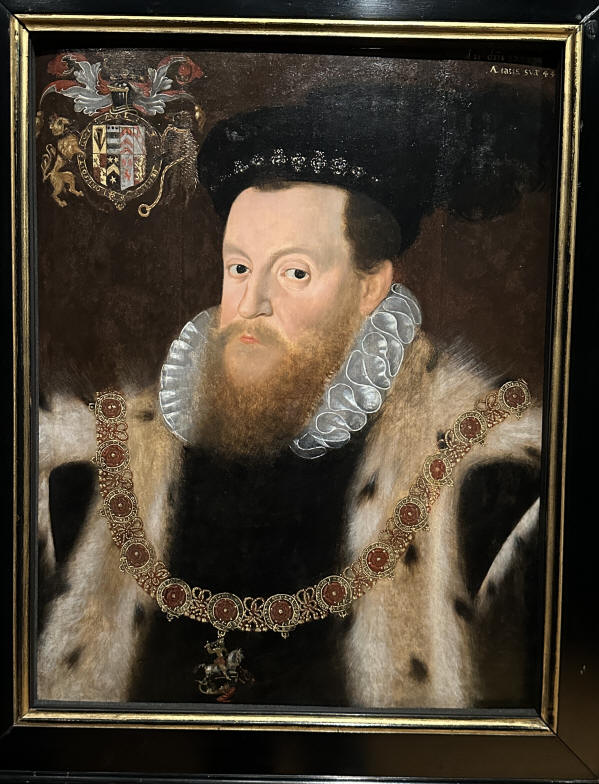 |
Day 2
Day two started with a walking tour of Kensington Park with “high tea” at Kensington Palace at the end. We had a dapper guide named Doug to ourselves, and he was a charming and engaging fellow who turned out to be a retired actor. He had a number of humous little anecdotes about the park’s history (like the fact that Oliver Cromwell, who led a successful insurrection against the English Monarchy for a few years, was exhumed from Westminster Abbey and his head was stuck on a pike in Hyde park for thirty years, and how Princess Dianna, after the divorce, stayed in Kensington Palace until she died and the next day the Royal family had every bit of her apartment gutted and destroyed within a few hours).
The man made circular pool outside Kensington palace was fairly entertaining, both because of the tameness and size of the ducks and swans (according to Doug, because everyone ignores the "don't feed the birds" sign) and a rather pecular art exhibit that we still haven't quite figured out.
|
|
|
||
In the afternoon, we went to see “Frameless,” an immersive art experience that was like something we’d done in France a few years earlier. Frameless was a set of full-projection rooms with slightly different themes, using famous artwork and music to provide a roughly 20-to-30-minute loop in each room. It was quite cool, actually, and in some ways was technical superior to the one in France; but the French version was in a gigantic, abandoned limestone quarry with a roof over it, and the music seemed better (maybe because one of the pieces was “Stairway to Heaven,” which was a distinct departure from the classical pieces used for most of it). Still very enjoyable.
Then we walked back to the hotel and went to a nouveau Indian restaurant, where I had a great scallop dish with some innovative (if not up to my standards) cocktails and Alison had food poisoning to go.
|
|
|
Day 3
Day 3 started with the British Museum, which like the National Gallery, was room after room of incredibly ancient stuff from pretty much everywhere in the world. The mummy exhibit had more mummies than we’ve seen in every prior experience in combination; they had some displays with a half dozen sarcophagus in them. Likewise what is now renamed “The Parthenon Room” turned out to have the ENTIRE TOP OF THE PARTHANON in it. Another room had an entire temple that had been disassembled and shipped back to Britain. Like the NG, it was so full of remarkable stuff it was overwhelming; you could easily spend the entire two hours in a single room and not exhaust everything to see.
|
Yes, the actual Jericho Tomb |
|
|
Yes, that is the actual rosetta stone |
Yes, the entire top of the actual Parthenon, originally called the Elgin Marbles (the guy who "acquired" them). Only 7000 years old.
|
Gollum |
Entire temple in the British Museum (the Nereid Monument) |
|
That's a lot of mummies. In a room with a lot more of them |
Inspiration for the classic R&R hit, "I wear my sunglasses at night" |
|
Cool Japanese stuff |
Ducks? They're here, there there, they're everywhere ... like Roy Kent |

The afternoon was the three-hour walking tour of Westminster and the Churchill War Museum. I thought that was three hours in total, but it turned out the walking tour was three hours, and then you were supposed to go spend another two hours at the war museum. After three hours (and roughly ten miles), we were burned out, and we needed to get ready for the play, so we bowed out at the end of the walk. The tour itself was fine although it was pretty much looking at the outside of buildings behind walls and through overarching trees while the (quite knowledgeable and entertaining) guide told you many, many things about them which we quickly forgot.
|
They still have gas lanterns in London! |
Charles the first, beheaded during the British Civil War. This Statue was given to a goldsmith who was paid to melt it down. Instead, he buried it and sold trinkets that he claimed were from the melted statue. And when the Monarchy was restored, sold the statue back to the Royals. |
|
Don't touch the horse. The guard is fine, but not the horse. |
This was most of the tour ... buildings behind walls and trees |
That evening, we went to see the play. If you haven’t seen the anime Spirited Away, stop reading, go find a TV, download it, and watch it. It’s still perhaps the best-known and most-loved anime in the world. The play did a remarkable job of bringing it to life and following the original story perfectly.
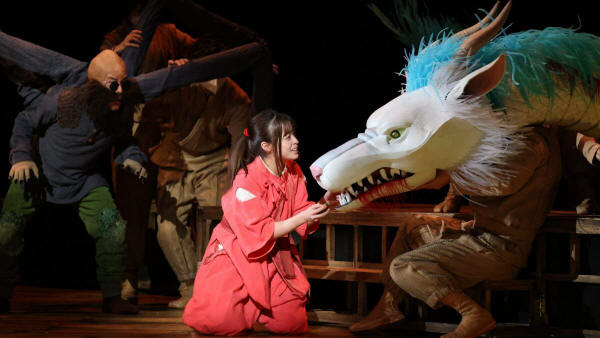 |
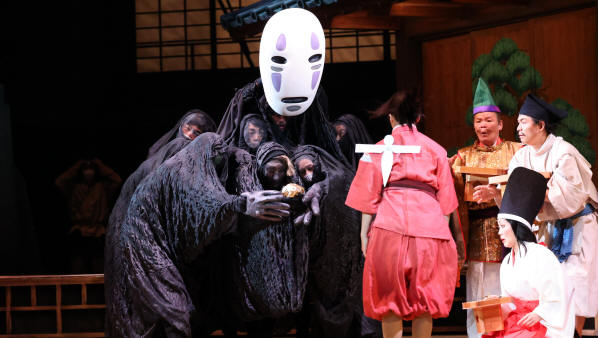 |
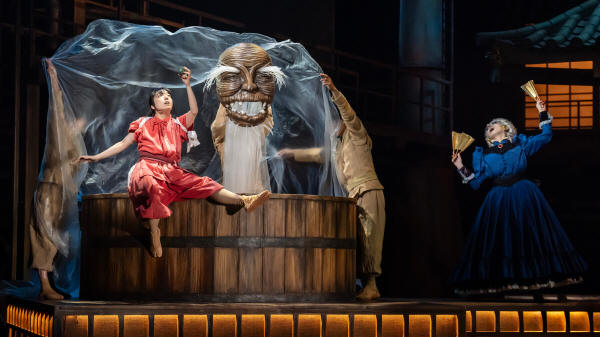 |
 |
Day 4
Day four was supposed to start with a Highgate Cemetery tour, but the food poisening from the Indian restaurant finally blossomed into an evening of violent stomach cramps and naseau, so Alison didn’t feel up to it in the morning.
In the afternoon, we did go to Buckingham Palace for the State Room tour which was my favorite part of the entire trip. The palace itself was impressive and had so many pictures, paintings, sculptures, boutique furniture, and crazy-ornate nicknacks that you could have spent an hour in each room and not exhausted things to look at. Unlike the British Museum, however, it felt harmonious and purposeful; it wasn’t just a collection of precious objects, it was, as they said many times, a working palace with themes and a feng shui flow from room to room that seemed natural and elegant.

The tour was constructed to funnel a significant number of people through the palace at a steady pace, and it did that admirably well. You received an audiovisual tablet about the size of a cell phone with headphones supporting a dozen languages. It had an overview of each room and then highlighted three or four items throughout the room with thirty to sixty-second spiels that played as you clicked along in order. It kept people moving at a steady pace. They also prohibited photos (and there were a lot of staff around to enforce it). No reason was given, but it seems obvious that it would slow people down if they were all trying to snapshots of the myriad items and the rooms themselves. The shots below are stock photos as a result.
 |
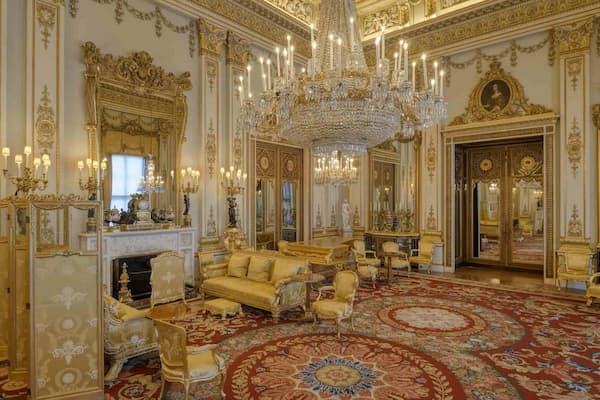 |
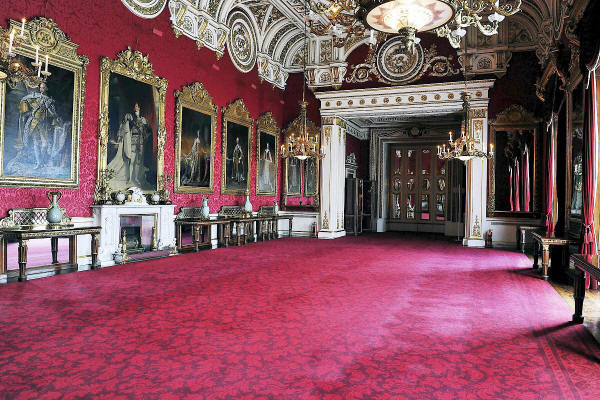 |
 |
 |
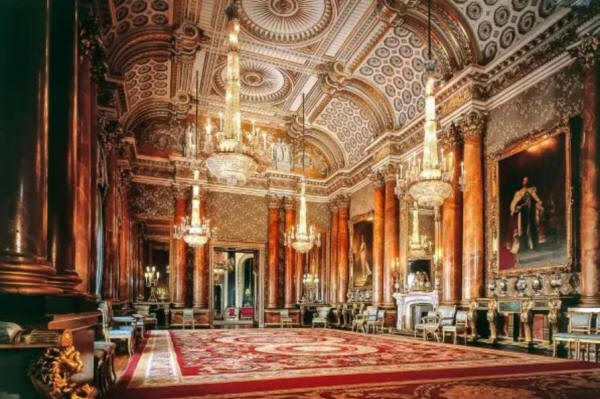 |
Entertaining things about Buckingham Palace:
- The primary architect, Nash, mentioned throughout the entire tour, was
sacked before the building was finished because of the spiraling cost of
the building. A more frugal architect was brought in to finish it
as cheaply as possible.
- Formal
dinners in the ballroom are not over when the King (or Queen) finishes;
instead, a set of twelve bagpipe players arrives and marches around the
room to force everyone to leave.
-
The palace is only open to the public during the summer while the King
is in Scotland.
- There is a
secret door in the White Room to the royal apartments where the King
lives, hidden behind a large mirror.
-
Buckingham Palace was built over the site of an open sewer (probably the
only location in London that was large enough to support the extensive
building and grounds, but I’m just guessing).
-
A young boy named Edward Jones (later founding the financial firm
bearing the same name in the US) broke into Buckingham Palace three
times, mostly to steal food, but also managed to nick some of Queen
Elizabeth’s underwear.
- Before the advent of gas lights, the palace employed a group of 30 people who did nothing but swap out candles in the many chandeliers in the State Rooms (and the gas lights were subsequently replaced with electricity, but the chandeliers themselves are still the originals).
- Trespassing is a minor offense in England, and so a new law was passed that made trespassing on Buckingham Palace grounds a "Serious Organized Crime" act punishable by death. Well, ok, it's "Organised" because it's England and it's not actually a death sentence, but still sort of funny.
Day 6 and 7
We spent with Brie, Aidan and Little Dave, just hanging out and
enjoying the company.

